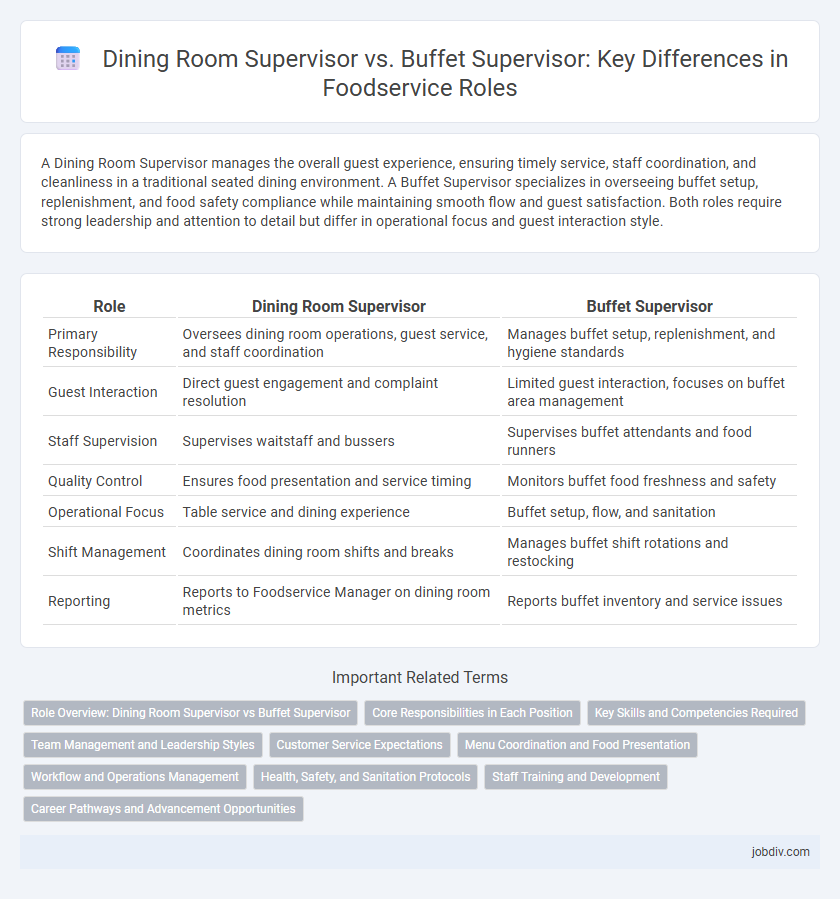A Dining Room Supervisor manages the overall guest experience, ensuring timely service, staff coordination, and cleanliness in a traditional seated dining environment. A Buffet Supervisor specializes in overseeing buffet setup, replenishment, and food safety compliance while maintaining smooth flow and guest satisfaction. Both roles require strong leadership and attention to detail but differ in operational focus and guest interaction style.
Table of Comparison
| Role | Dining Room Supervisor | Buffet Supervisor |
|---|---|---|
| Primary Responsibility | Oversees dining room operations, guest service, and staff coordination | Manages buffet setup, replenishment, and hygiene standards |
| Guest Interaction | Direct guest engagement and complaint resolution | Limited guest interaction, focuses on buffet area management |
| Staff Supervision | Supervises waitstaff and bussers | Supervises buffet attendants and food runners |
| Quality Control | Ensures food presentation and service timing | Monitors buffet food freshness and safety |
| Operational Focus | Table service and dining experience | Buffet setup, flow, and sanitation |
| Shift Management | Coordinates dining room shifts and breaks | Manages buffet shift rotations and restocking |
| Reporting | Reports to Foodservice Manager on dining room metrics | Reports buffet inventory and service issues |
Role Overview: Dining Room Supervisor vs Buffet Supervisor
A Dining Room Supervisor manages front-of-house operations, ensuring seamless guest service, staff coordination, and maintaining high standards of cleanliness and ambiance within the dining area. In contrast, a Buffet Supervisor oversees the setup, replenishment, and presentation of buffet stations, prioritizing food safety compliance, portion control, and efficient flow of guests. Both roles require strong leadership and customer service skills but focus on different aspects of foodservice supervision.
Core Responsibilities in Each Position
Dining Room Supervisors manage front-of-house operations, ensuring exceptional guest service, staff coordination, and smooth dining experiences. Buffet Supervisors oversee buffet setup, food presentation, quality control, and maintain hygiene standards throughout service periods. Both roles require strong leadership, but Dining Room Supervisors focus more on guest interaction while Buffet Supervisors concentrate on food display and replenishment.
Key Skills and Competencies Required
Dining Room Supervisors excel in customer service management, team leadership, and conflict resolution, ensuring seamless dining experiences and maintaining high standards of food safety and hygiene. Buffet Supervisors require expertise in inventory control, food presentation, and portion management, coupled with strong organizational skills to oversee buffet setup and replenishment efficiently. Both roles demand excellent communication, attention to detail, and the ability to coordinate staff schedules to optimize operational flow in foodservice environments.
Team Management and Leadership Styles
A Dining Room Supervisor excels in hands-on team management, coordinating front-of-house staff with a focus on delivering personalized guest experiences while employing transformational leadership to motivate and develop individual team members. In contrast, a Buffet Supervisor emphasizes operational efficiency and volume management, utilizing transactional leadership to enforce procedures and maintain consistent service flow in high-capacity environments. Both roles require distinct leadership styles aligned with their specific service models to optimize staff performance and guest satisfaction.
Customer Service Expectations
Dining Room Supervisors ensure seamless customer service by managing table assignments, overseeing staff, and addressing guest needs promptly to maintain a high-quality dining experience. Buffet Supervisors focus on maintaining food presentation, replenishing items, and guiding guests through buffet service while ensuring cleanliness and food safety standards. Both roles demand strong communication skills and attentiveness to guest satisfaction, but Dining Room Supervisors prioritize personalized service, whereas Buffet Supervisors emphasize efficient self-service support.
Menu Coordination and Food Presentation
A Dining Room Supervisor oversees menu coordination by collaborating with chefs to ensure seamless service and consistent dish quality, enhancing the overall dining experience. A Buffet Supervisor focuses on arranging food presentation meticulously, maintaining aesthetic appeal and freshness to attract guests while managing replenishment schedules. Both roles require attention to detail, but the Dining Room Supervisor emphasizes service flow, whereas the Buffet Supervisor prioritizes visual presentation and buffet layout.
Workflow and Operations Management
A Dining Room Supervisor oversees table service operations, ensuring seamless coordination between waitstaff, kitchen, and guests to maintain high service standards and efficient guest flow. In contrast, a Buffet Supervisor manages buffet setup, food replenishment, and guest traffic patterns to optimize station efficiency and minimize wait times. Both roles require strong workflow management but differ in focus; the Dining Room Supervisor emphasizes personalized guest interaction while the Buffet Supervisor concentrates on maintaining buffet station order and hygiene.
Health, Safety, and Sanitation Protocols
Dining Room Supervisors ensure strict adherence to health, safety, and sanitation protocols by overseeing table setups, waitstaff hygiene practices, and customer area cleanliness to prevent contamination and foodborne illnesses. Buffet Supervisors implement rigorous monitoring of food temperatures, proper utensil usage, and frequent sanitation of serving stations to maintain compliance with safety regulations and minimize cross-contamination risks. Both roles require continuous staff training on updated food safety standards and coordination with health inspectors to uphold organizational and legal sanitation requirements.
Staff Training and Development
Dining Room Supervisors prioritize comprehensive staff training in table service, guest interaction, and fine dining etiquette to enhance overall customer experience. Buffet Supervisors focus training on efficient food replenishment, hygiene standards, and managing large crowds to ensure smooth buffet operations. Both roles require continuous development programs to maintain high service quality and adapt to evolving foodservice trends.
Career Pathways and Advancement Opportunities
Dining Room Supervisors manage front-of-house staff and ensure guest satisfaction, often progressing to restaurant or hotel management roles due to their comprehensive customer service skills. Buffet Supervisors specialize in buffet operations, focusing on food presentation and flow, which can lead to opportunities in culinary management or large-scale event coordination. Both career pathways offer advancement opportunities, with Dining Room Supervisors typically moving towards broader hospitality management positions and Buffet Supervisors advancing into specialized foodservice or catering management roles.
Dining Room Supervisor vs Buffet Supervisor Infographic

 jobdiv.com
jobdiv.com